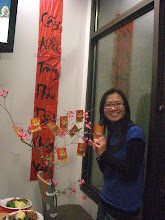Tết in the three Vietnamese regions can be divided into three periods, known as Before New Year's Eve, New Year's Eve, and the New Year, representing the preparation before Tết, the eve of Tết, and the days of and following Tết, respectively. All of these customs are to celebrate Tết in Vietnam.
Before New Year's Eve begins one or two weeks before the actual celebration. The general atmosphere leading up to Tết is in the bustle of shopping, decorating the home, cooking traditional Tết food and waiting for relatives to return home. People try to pay off their debts in advance so that they can be debt-free on Tết. Parents buy new clothes for their children so that the children can wear them when Tết arrives. Because a lot of commercial activity will cease during the celebrations, people try to stock up on supplies as much as possible.
In the days leading up to Tết, the streets and markets are full of people. Since the shops will be closed during Tết, everyone is busy buying food, clothes, and decorations for their house.
Vietnamese families usually have a family altar, to pay respect to their ancestors. Vietnamese families have a tray of five fruits on their altar called "Ngũ Quả", including banana, orange, kumquat, pomelo and finger citron . Each fruit conveys a different meaning. Pomelos promise a lucky and sweet year. Banana and finger citron symbolize a protective hand while kumquats and oranges represent success and prosperity. During Tết the altar is thoroughly cleaned and new offerings are placed there. Traditionally, the three kitchen guardians for each house (Kitchen God), who report to the Jade Emperor about the events in that house over the past year, return to heaven on the 23rd day of the twelfth month by lunar calendar. Their departure is marked by a modest ceremony where the family offers sacrifices for them to use on their journey.
In the days leading up to Tết, each family cooks special holiday foods such as "banh chung" and "banh day". Preparations for these foods are quite extensive. Family members often take turns to keep watch on the fire overnight, telling each other stories about Tết of past years.
Before New Year's Eve is my favored period. When I was child, I always stayed home and waited for my mum coming back from market. She bought many many things I loved. When I grow up, I'm always exciting to go to market to buy special things for New Year and go shopping with my friends to choose beautiful cloths. Moreover, I like to help my parent decorate our house, clean house, and cook special food.
During this period, companies celebrate parties for their workers in the restaurants. These parties are grateful to their workers for working hard to improve companies and cheer their successful business during a year. For Vietnamese families, Before New Year's Eve parties occur in their own house and they invite their relatives and close friends.
Look their mom and grandma make "banh tet"
Cooking "banh tet" with his mom during a night and reminding old stories.
Before New Year's Eve party of a company
















